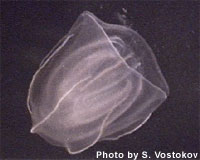|
||
ATTACHMENT 17. Possible Consequences of the Mnemiopsis
invasion Henri J Dumont (Ghent) That the Caspian would offer to Mnemiopsis a physical-chemical and biotic environment superior to that of the Black Sea was easy to predict. The speed with which the comb jelly has expanded here since its first sighting in late 1999 confirms this.
In contrast to the impoverished Black Sea, the Caspian, a crustacean sea, harbours numerous endemic taxa among the Amphipoda, Mysidacea, and Cumacea. These are largely benthic, but also in part pelagic. They tend to leave the substratum, especially at night. Mnemiopsis is likely to cause havoc among these as well, and much irreplacable biodiversity may be lost in the process. By quantitiative changes I mean changes in the functioning of the Caspian ecosystem due to the selective removal of key zooplankters and benthos. Algae and suspended particles will no longer be filtered out of the pelagic, and algae will either multiply, possibly causing waterblooms (especially in shallow, semi-enclosed bays), or sediment to the bottom. The Mollusca are a group that may possibly benefit from this change. Finally, there will be important domino-effects: the removal of the zooplankton, and the consumption of pelagic fish-eggs, will severely undermine the pelagic sardine (kilka) populations. Like in the Black Sea, their collapse will knock a large number of fishermen out of business. At the top of the trophic cascade sits the Caspian seal, totally dependent on sardines for its feeding. Collapse, and possibly extinction of the seal population will probably be the most “visual” effect of Mnemiopsis, but will represent only one out of a couple hundred species that will be severely affected.
|
Meeting Report
Attachment
1 |
|


 Expected effects can be separated in two
kinds: qualitative and quantitative. Qualitative effects are of a kind that will lead to
the elimination of certain biota, either directly, or indirectly, by the comb jelly.
Mnemiopsis, an indiscriminate pelagic hunter, will primarily attack the zooplankton, and
because it is capable of expanding as long as it can find food, it will likely drive the
zooplankton to near-extinction. Some more vulnerable species may effectively go extinct.
Unfortunately, the “naïve” caspian endemics of the group of the Onychopoda are likely
to be among them. The copepod fraction, more agile and adaptable, may survive.
Expected effects can be separated in two
kinds: qualitative and quantitative. Qualitative effects are of a kind that will lead to
the elimination of certain biota, either directly, or indirectly, by the comb jelly.
Mnemiopsis, an indiscriminate pelagic hunter, will primarily attack the zooplankton, and
because it is capable of expanding as long as it can find food, it will likely drive the
zooplankton to near-extinction. Some more vulnerable species may effectively go extinct.
Unfortunately, the “naïve” caspian endemics of the group of the Onychopoda are likely
to be among them. The copepod fraction, more agile and adaptable, may survive.